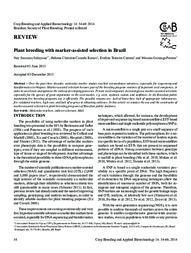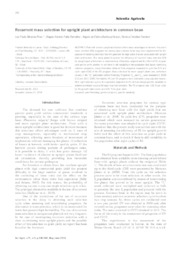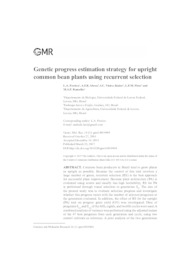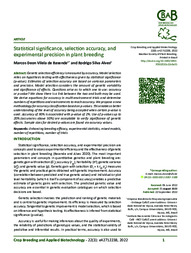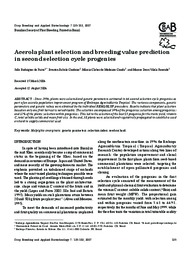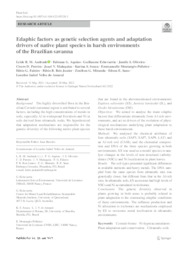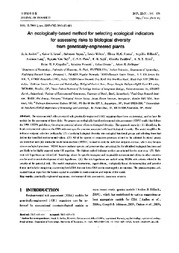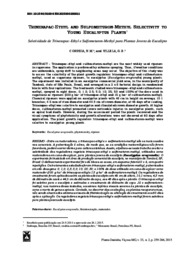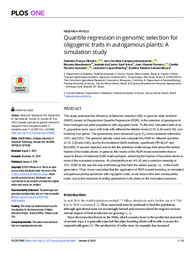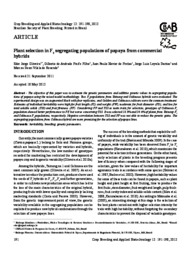Search Publications
Filter by:
| Author(s): SAKIYAMA, N. S.; RAMOS, H. C. C.; CAIXETA, E. T.; PEREIRA, M. G. Over the past three decades, molecular marker studies reachedextraordinary advances, especially for sequencing and bioinformatics techniques.Marker-assisted selectionbecamepart of the breeding program... ... |
| Author(s): PIRES, L. P. M.; RAMALHO, M. A. P.; ABREU, A. de F. B.; FERREIRA, M. C. Plant with a more upright architecture offers many advantages to farmers. Recurrent mass selection (RS) programs for carioca type common bean have been implemented for the purpose of obtaining new lin... ... |
| Author(s): PEREIRA, L. A.; ABREU, A. F. B.; VIEIRA JÚNIOR, I. C.; PIRES, L. P. M.; RAMALHO, M. A. P. Common bean producers in Brazil tend to grow plants as upright as possible. Because the control of this trait involves a large number of genes, recurrent selection (RS) is the best approach for succes... ... |
| Author(s): RESENDE, M. D. V. de; ALVES, R. S. Genetic selection efficiency is measured by accuracy. Model selection relies on hypothesis testing with effectiveness given by statistical significance (p-value). Estimates of selection accuracy are b... ... |
| Author(s): PAIVA, J. R. de; CORDEIRO, E. R.; CORRÊA, M. C. de M.; RESENDE, M. D. V. Since 1996, plants were selected and genetic parameters estimated in 64 second selection cycle progenies as part of an acerola population improvement program of Embrapa Agroindústria Tropical. The var... ... |
| Author(s): ANDRADE, L. R. M. de; AQUINO, F. de G.; ECHEVARRIA, G.; OLIVEIRA, J. S.; PEREIRA, C. D.; MALAQUIAS, J. V.; SOUZA, K. S.; MONTARGÈS-PELLETIER, E.; FALEIRO, F. G.; REIS JUNIOR, F. B. dos; MIRANDA, Z. de J. G.; SANO, E. E.; AMARAL, L. I. V. do Abstract Purposes To analyze the main edaphic factors that differentiate ultramafic from typical Cerrado environments and act as agents of the development of biochemical and morphological mechanisms o... ... |
| Author(s): ANDOW, D. A.; LOVEI, G. L.; ARPAIA, S.; WILSON, L.; FONTES, E. M. G.; HILBECK, A.; LANG, A.; TUAT, N. V.; PIRES, C. S. S.; SUJII, E. R.; ZWAHLEN, C.; BIRCH, A. N. E.; CAPALBO, D. M. F.; PRESCOTT, K.; OMOTO, C.; ZEILINGER, A. R. The environmental risks associated with genetically-engineered (GE) organisms have been controversial, and so have the models for the assessment of these risks. We propose an ecologically-based enviro... ... |
| Author(s): CORREIA, N. M.; VILLELA, G. B. The objective of this study was to assess the selectivity of the plant growth regulators trinexapac-ethyl and sulfometuronmethyl, used as sugarcane ripeners, to eucalyptus (Eucalyptus urograndis) youn... ... |
| Author(s): OLIVEIRA, G. F.; NASCIMENTO, A. C. C.; NASCIMENTO, M.; SANT'ANNA, I. de C.; ROMERO, J. V.; AZEVEDO, C. F.; BHERING, L. L.; CAIXETA, E. T. This study assessed the efficiency of Genomic selection (GS) or genome‐wide selection (GWS), based on Regularized Quantile Regression (RQR), in the selection of genotypes to breed autogamous pla... ... |
| Author(s): OLIVEIRA, E. J. de; FRAIFE FILHO, G. de A.; FREITAS, J. P. X. de; DANTAS, J. L. L.; RESENDE, M. D. V. de The objective of this paper was to estimate the genetic parameters and additive genetic values in segregating populations of papaya using the mixed model methodology. Two F2 populations from Tainung a... ... |
Observation
Some of Embrapa's publications are published as ePub files. To read them, use or download one of the following free software options to your computer or mobile device. Android: Google Play Books; IOS: iBooks; Windows and Linux: Calibre.
Access other publications
Access the Agricultural Research Database (BDPA) to consult Embrapa's full library collection and records.
Visit Embrapa Bookstore to purchase books and other publications sold by Embrapa.

